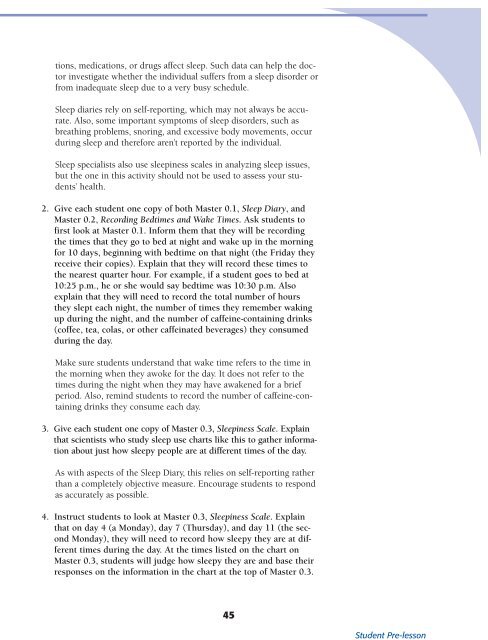Biological - NIH Office of Science Education - National Institutes of ...
Biological - NIH Office of Science Education - National Institutes of ...
Biological - NIH Office of Science Education - National Institutes of ...
You also want an ePaper? Increase the reach of your titles
YUMPU automatically turns print PDFs into web optimized ePapers that Google loves.
tions, medications, or drugs affect sleep. Such data can help the doctor<br />
investigate whether the individual suffers from a sleep disorder or<br />
from inadequate sleep due to a very busy schedule.<br />
Sleep diaries rely on self-reporting, which may not always be accurate.<br />
Also, some important symptoms <strong>of</strong> sleep disorders, such as<br />
breathing problems, snoring, and excessive body movements, occur<br />
during sleep and therefore aren’t reported by the individual.<br />
Sleep specialists also use sleepiness scales in analyzing sleep issues,<br />
but the one in this activity should not be used to assess your students’<br />
health.<br />
2. Give each student one copy <strong>of</strong> both Master 0.1, Sleep Diary, and<br />
Master 0.2, Recording Bedtimes and Wake Times. Ask students to<br />
first look at Master 0.1. Inform them that they will be recording<br />
the times that they go to bed at night and wake up in the morning<br />
for 10 days, beginning with bedtime on that night (the Friday they<br />
receive their copies). Explain that they will record these times to<br />
the nearest quarter hour. For example, if a student goes to bed at<br />
10:25 p.m., he or she would say bedtime was 10:30 p.m. Also<br />
explain that they will need to record the total number <strong>of</strong> hours<br />
they slept each night, the number <strong>of</strong> times they remember waking<br />
up during the night, and the number <strong>of</strong> caffeine-containing drinks<br />
(c<strong>of</strong>fee, tea, colas, or other caffeinated beverages) they consumed<br />
during the day.<br />
Make sure students understand that wake time refers to the time in<br />
the morning when they awoke for the day. It does not refer to the<br />
times during the night when they may have awakened for a brief<br />
period. Also, remind students to record the number <strong>of</strong> caffeine-containing<br />
drinks they consume each day.<br />
3. Give each student one copy <strong>of</strong> Master 0.3, Sleepiness Scale. Explain<br />
that scientists who study sleep use charts like this to gather information<br />
about just how sleepy people are at different times <strong>of</strong> the day.<br />
As with aspects <strong>of</strong> the Sleep Diary, this relies on self-reporting rather<br />
than a completely objective measure. Encourage students to respond<br />
as accurately as possible.<br />
4. Instruct students to look at Master 0.3, Sleepiness Scale. Explain<br />
that on day 4 (a Monday), day 7 (Thursday), and day 11 (the second<br />
Monday), they will need to record how sleepy they are at different<br />
times during the day. At the times listed on the chart on<br />
Master 0.3, students will judge how sleepy they are and base their<br />
responses on the information in the chart at the top <strong>of</strong> Master 0.3.<br />
45<br />
Student Pre-lesson

















